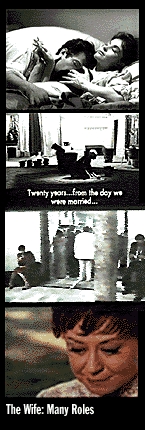
Particularly in 8-1/2 and La Dolce Vita, he strongly casts the wife in the role of mother substitute. Note the suckling posture in the top image at right, as Marcello in effect finds comfort at his wife/mother's breast after a period of stress and conflict. Expectations for the mothering role also extends to maintaining the household, as shown in the second image, with the wife/mother selflessly cleaning house in Marcello's 8-1/2 harem fantasy. In this image, her mundane tasks are put in a glorious light reflecting many children's misperceptions (or unfair expections) of a mother's attitude toward housework. A mother's role also includes a mix of love for and authority over the children, and like most children, Marcello finds the former indispensible while the latter, intolerable. This is illustrated best in Marcello's final argument with Emma, where he alternates between leaving her and returning, breaking the bonds and finally returning to her bosom. In all of the films, the husband and wife invariably have difficulty communicating or understanding each other's needs and expectations. The third image, from City of Women, visually communicates this problem with multiple barriers — physical (column and doorway), spatial (opposite ends of a wide screen image) and social (crowd with turned backs). Julieta is the most whole representation of the wife, playing all of the above roles along with that of a complete person with an interior life and multifaceted personality. Fellini made this clear from the outset, with his play of mirrors and reflections within reflections. With these images, he simultaneously communicated her many-sidedness, her internal confusion and her self-deception.
|
|
|
 Fellini's wife recurs in each of these films (counting Gelsomina effectively
playing that role in La Strada). Fellini depicts the wife playing
the multiple roles that he needs of her, as well as those that he would rather
not see. These include nurturer and housekeeper (i.e. mother substitute),
demanding and needy creature, partner in a failing relationship, at times
the wife even plays the role of a complete human being with a life of her
own (primarily in Juliet).
Fellini's wife recurs in each of these films (counting Gelsomina effectively
playing that role in La Strada). Fellini depicts the wife playing
the multiple roles that he needs of her, as well as those that he would rather
not see. These include nurturer and housekeeper (i.e. mother substitute),
demanding and needy creature, partner in a failing relationship, at times
the wife even plays the role of a complete human being with a life of her
own (primarily in Juliet).



